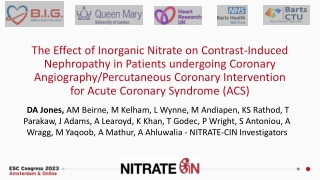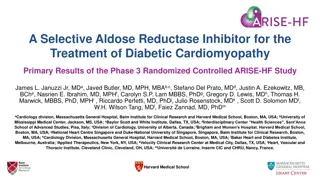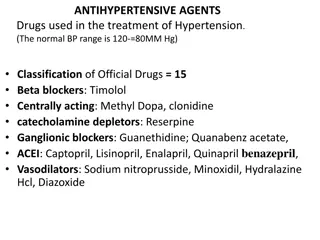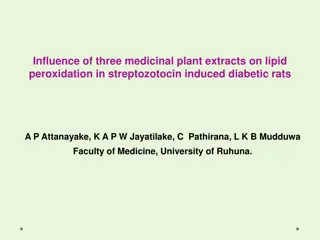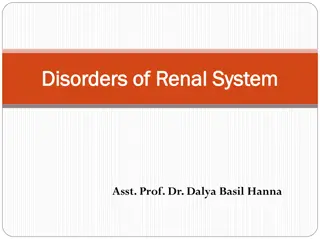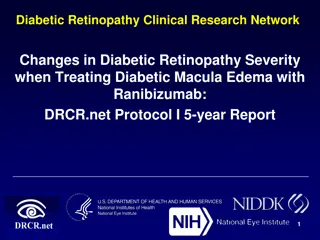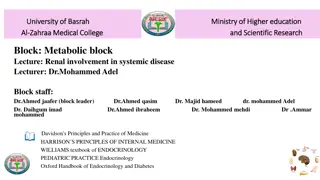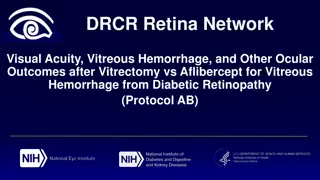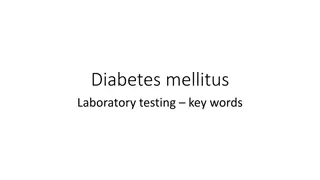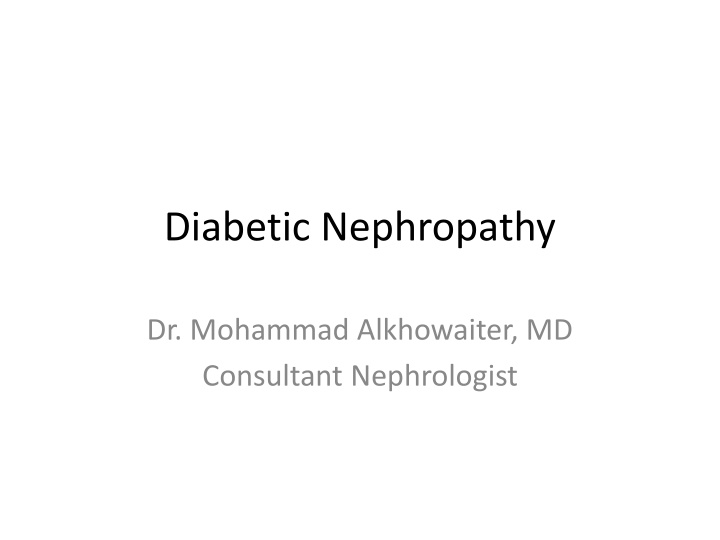
Diabetic Nephropathy
Diabetic nephropathy refers to functional and structural renal changes that occur in individuals with diabetes mellitus, leading to albuminuria and progressive loss of renal function. It is a significant health concern, being the primary cause of end-stage renal disease and a risk factor for cardiovascular diseases. The prevalence of diabetic nephropathy is notable in various countries, emphasizing the importance of early detection and management in diabetic patients.
Download Presentation

Please find below an Image/Link to download the presentation.
The content on the website is provided AS IS for your information and personal use only. It may not be sold, licensed, or shared on other websites without obtaining consent from the author. If you encounter any issues during the download, it is possible that the publisher has removed the file from their server.
You are allowed to download the files provided on this website for personal or commercial use, subject to the condition that they are used lawfully. All files are the property of their respective owners.
The content on the website is provided AS IS for your information and personal use only. It may not be sold, licensed, or shared on other websites without obtaining consent from the author.
E N D
Presentation Transcript
Diabetic Nephropathy Dr. Mohammad Alkhowaiter, MD Consultant Nephrologist
Outline Definition Importance/Epidemiology Pathogenesis Natural History Risk factors and prevention Treatment strategies
Definition Diabetic nephropathy: - Functional and structural renal changes that happen in the context of Diabetes mellitus. Functional: - Albuminuria - Progressive loss of renal function Strucural: - Mesangial expansion, GBM thickening and glomerulosclerosis
Definition Microalbuminuria = 30-300 mg/d ACR > 3 mg/mmol creatinine Albuminuria = > 300 mg/d Urine Cr 1 g = 10 mmol ACR 3000 mg/g = 300 mg/mmol
Importance The leading cause of ESRD in our society SCOT 2015
Importance Diabetic nephropathy is a risk factor for cardiovascular disease
Importance Prevalence of Diabetes in Saudi Arabia: - 23.7% DM - 14.1 % impaired fasting glucose - In total 37.8% have abnormal glucose metabolism (age 30-70 year) Epidemic Alnozha et al, Saudi Med J 2004, 25(11): 1603 10.
Prevalence of Diabetic Nephropathy in Type II 11.5% in UK 42.9% in Thailand Saudi Arabia: - 10.8% the Saudi National Diabetes Registry (SNDR), Al-Rubeaan et al 2014. - 31.8% Alwakeel et al, Ann Saudi Med 2011; 31(3): 236 242.
ESRD in DM II: - 1.5% of type II DM the Saudi National Diabetes Registry (SNDR), Al-Rubeaan et al 2014. - 5% of type II DM Alwakeel et al, Ann Saudi Med 2011; 31(3): 236 242.
Type 2 10 years: 25% MA, 5% proteinuria and 0.8% Cr 175 or renal replacement therapy Adler AI, et al. Kidney Int 2003; 63:225. Type 1 7-10% ESRD after 20-30 year
Natural Hx inType I DM Stengal et al, Mayo Clin Proc, 2000
Pathophysiology Hyperfiltration
http://emcrit.org/pulmcrit/renal-microvascularhemodynamics-in-sepsis-a-new-paradigm/http://emcrit.org/pulmcrit/renal-microvascularhemodynamics-in-sepsis-a-new-paradigm/ December 2, 2014 by Josh Farkas
Pathophysiology Hyperglycemia increases the expression of transforming growth factor-beta (TGF-beta) Hyperglycemia and AGEs (advanced glycation end products ) Hyperglycemia Increases VEGF expression (vascular endothelial growth factor) HTN
Risk Factors Duration of DM Age HTN Race Genetic factor Retinopathy Smoking, Hyperlipidemia Poor Glycemic control
Diabetic Nephropathy and Retinopathy In Type I DM In Type II DM
Treatment Strategies Good BP control - BP <130/80 RAS blockade, independent of BP Good glycemic control - HgbA1C <7 % Lipid lowering agent - LDL-C <2.0 mmol/L Diet (protein, sodium)
The Diabetes Control and Complications Trial Research Group. N Engl J Med 1993
Adapted from data published in: Lewis EJ, Hunsicker LG, Clarke WR, et al. N Engl J Med 2001; 345:851.
Summery Prevalence of Diabetic Nephropathy is underestimated. Microalbuminuria is a risk of further renal progression. DN is a risk for cardiovascular events. Half of the Microalbuminuric patient will progress to overt nephropathy. DN is a leading cause of ESRD in our society and worldwide.
Treatment Strategies Good BP control - BP <130/80 RAS blockade, independent of BP Good glycemic control - HgbA1C <7 % Lipid lowering agent - LDL-C <2.0 mmol/L Diet (protein, sodium)
Thank you malkhowaiter@ksu.edu.sa

